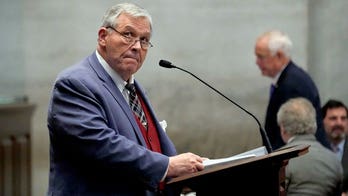Kurtz: Why Trump doesn't bow to the right
'MediaBuzz' host says Donald Trump has long been preparing his campaign for the general election
Donald Trump, whose big Super Tuesday night brings him one step closer to the November ballot, has been running a general election campaign from the beginning.
Trump and his inner circle never advertised this, of course, and are amused by how the media have largely missed the strategy.
While Hillary Clinton, who also had a big day yesterday, had her aides leak details to the New York Times and Washington Post of how she’s planning a general-election assault on Trump, the Republican front-runner has had his eye on the fall since day one.
People familiar with his approach say some strategic elements evolved as the campaign unfolded. There was no 100-page memo plotting it out in advance. But this mindset explains why Trump has done certain things that are wildly unorthodox in a Republican primary race, much to the anger and consternation of leading conservative politicos and pundits.
One linchpin of this strategy came in Trump’s announcement speech, when he stirred controversy by saying that illegal Mexican immigrants included criminals and rapists. That, and his vow to build a wall across the border, gave him credibility with the conservative base. Whenever Trump would take a more moderate stance that might alienate that base, he could just pivot back to his tough immigration stance.
Trump declared early on that there should be no cuts to Social Security and Medicare. That, as his campaign knows full well, is not the standard Republican line. Conservatives believe deeply in shrinking the size of government and that entitlement programs must be reined in because they eat up a major chunk of the budget.
But Democrats have been accusing Republicans of wanting to gut the programs for a generation. Trump’s position—that people paid into the program and deserve to reap the benefits—plays well in a general election, especially since he hopes to peel off some working-class Democrats and independents.
In his press conference last night, Trump again sung the praises of Planned Parenthood, saying he would only defund the group’s abortion services—despite what the “so-called conservatives” think. This may be anathema to conservative Republicans who despise the group and are ardently pro-life. But his stance could appeal to suburban women who might otherwise view a Republican nominee as hostile.
Trump, at his rallies, routinely tries out different narratives and drops the ones that don’t work. But he has settled on a mix of conservative and moderate positions that partially explains why Ted Cruz and Marco Rubio keep attacking him as an inauthentic conservative.
Trump has never run as a doctrinaire right-winger. He has, after all, spoken repeatedly about raising taxes on hedge-fund executives, which is usually a Democratic talking point.
Trump certainly sounded like a general-election candidate last night, taking a more subdued tone and talking about sitting in the Oval Office and making deals with Democrats and Republicans. The press conference setting yielded a more subdued tone—he even said nice things about the press!—and got him 40 minutes of precious cable airtime.
The general-election strategy was also evident in Trump’s travel schedule. While some pundits questions why he wasn’t spending more time in Iowa or New Hampshire, he would jet off for rallies in Alabama and Mississippi or Massachusetts and Vermont. This was in part because he would need those states later in the primaries, but also to lay the groundwork for November.
Most Republican candidates move right during the primaries and then slide to the center a bit during the fall campaign, while Democrats do the opposite. If the Super Tuesday results indeed mean that Trump is close to becoming the party’s standard-bearer, he may not have to pivot as much as most nominees.





